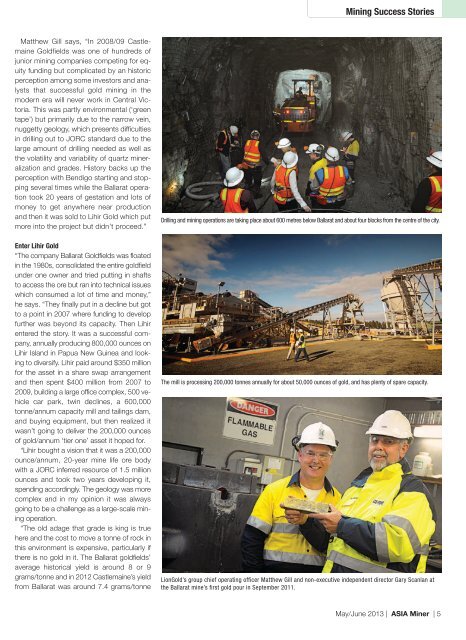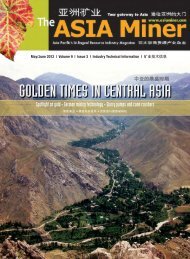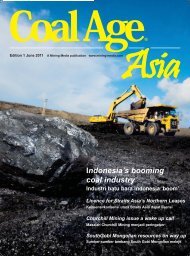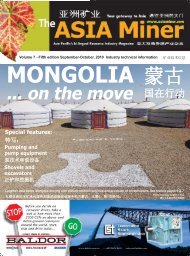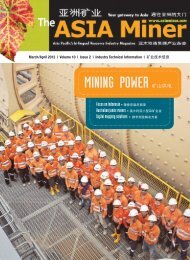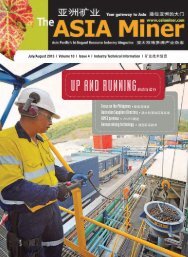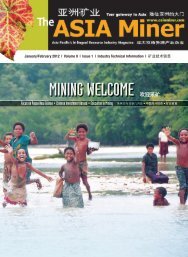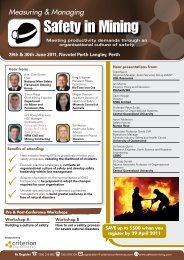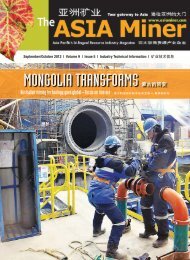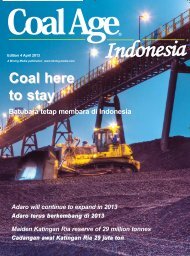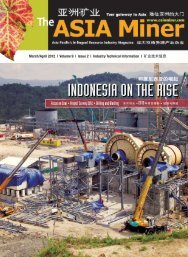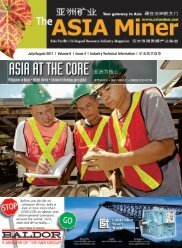May/June 2013 - The ASIA Miner
May/June 2013 - The ASIA Miner
May/June 2013 - The ASIA Miner
You also want an ePaper? Increase the reach of your titles
YUMPU automatically turns print PDFs into web optimized ePapers that Google loves.
Mining Success Stories<br />
Matthew Gill says, “In 2008/09 Castlemaine<br />
Goldfields was one of hundreds of<br />
junior mining companies competing for equity<br />
funding but complicated by an historic<br />
perception among some investors and analysts<br />
that successful gold mining in the<br />
modern era will never work in Central Victoria.<br />
This was partly environmental (‘green<br />
tape’) but primarily due to the narrow vein,<br />
nuggetty geology, which presents difficulties<br />
in drilling out to JORC standard due to the<br />
large amount of drilling needed as well as<br />
the volatility and variability of quartz mineralization<br />
and grades. History backs up the<br />
perception with Bendigo starting and stopping<br />
several times while the Ballarat operation<br />
took 20 years of gestation and lots of<br />
money to get anywhere near production<br />
and then it was sold to Lihir Gold which put<br />
more into the project but didn’t proceed.”<br />
Enter Lihir Gold<br />
“<strong>The</strong> company Ballarat Goldfields was floated<br />
in the 1980s, consolidated the entire goldfield<br />
under one owner and tried putting in shafts<br />
to access the ore but ran into technical issues<br />
which consumed a lot of time and money,”<br />
he says. “<strong>The</strong>y finally put in a decline but got<br />
to a point in 2007 where funding to develop<br />
further was beyond its capacity. <strong>The</strong>n Lihir<br />
entered the story. It was a successful company,<br />
annually producing 800,000 ounces on<br />
Lihir Island in Papua New Guinea and looking<br />
to diversify. Lihir paid around $350 million<br />
for the asset in a share swap arrangement<br />
and then spent $400 million from 2007 to<br />
2009, building a large office complex, 500 vehicle<br />
car park, twin declines, a 600,000<br />
tonne/annum capacity mill and tailings dam,<br />
and buying equipment, but then realized it<br />
wasn’t going to deliver the 200,000 ounces<br />
of gold/annum ‘tier one’ asset it hoped for.<br />
“Lihir bought a vision that it was a 200,000<br />
ounce/annum, 20-year mine life ore body<br />
with a JORC inferred resource of 1.5 million<br />
ounces and took two years developing it,<br />
spending accordingly. <strong>The</strong> geology was more<br />
complex and in my opinion it was always<br />
going to be a challenge as a large-scale mining<br />
operation.<br />
“<strong>The</strong> old adage that grade is king is true<br />
here and the cost to move a tonne of rock in<br />
this environment is expensive, particularly if<br />
there is no gold in it. <strong>The</strong> Ballarat goldfields’<br />
average historical yield is around 8 or 9<br />
grams/tonne and in 2012 Castlemaine’s yield<br />
from Ballarat was around 7.4 grams/tonne<br />
Drilling and mining operations are taking place about 600 metres below Ballarat and about four blocks from the centre of the city.<br />
<strong>The</strong> mill is processing 200,000 tonnes annually for about 50,000 ounces of gold, and has plenty of spare capacity.<br />
LionGold’s group chief operating officer Matthew Gill and non-executive independent director Gary Scanlan at<br />
the Ballarat mine’s first gold pour in September 2011.<br />
<strong>May</strong>/<strong>June</strong> <strong>2013</strong> | <strong>ASIA</strong> <strong>Miner</strong> | 5


